Ways to protect the car body from chips and scratches
Content
The operation of even a very high-quality car is associated for its owner with unpleasant surprises in the form of scratches and chips on the body, which is why the appearance of the “iron horse” loses its presentable appearance. In order for the paintwork to remain “like new” for longer, additional protection of the car body from chips and scratches is necessary using one of the modern methods.
Content
- 1 Why body protection is needed
- 2 Modern ways to protect the paintwork
- 2.1 Anti-gravel film
- 2.2 Vinyl wrap
- 2.3 Ceramic protection "liquid glass"
- 2.4 "Liquid Case"
- 2.5 Protective polishes and waxes
- 2.6 Liquid rubber
- 2.7 Fabric case
- 2.8 Plastic deflectors
- 3 Top cars with the best body protection
Why body protection is needed
If the car is in a warm garage, securely covered with a dense cover, it will retain the shine and richness of the paintwork for a long time. What can not be said about the car, which is actively exploited. Each thousand kilometers traveled adds dozens of scratches, chips, microscopic cracks to the appearance of the “iron horse”.
Great damage to the "native" car coating is caused by birds, the droppings of which contain acid that corrodes the varnish. No less harm is fraught with precipitation and bright rays of the sun. In winter, things are even worse: tons of chemicals spilled onto the roads corrode everything in their path. Under their influence, the car paint fades, cracks.
This problem has gained particular relevance in the last four or five years, when, under the influence of environmental standards, manufacturers began to cover cars with less durable varnishes than before. Even a small grain of sand stuck in a sponge or a rag that was used to wipe the body can leave a generous painting on the car. What can we say about the "surprises" left by the neighbors in the parking lot or the pebbles that fly from under the wheels of the cars in front.
Additional body protection helps to minimize all negative effects on the paintwork.
Modern ways to protect the paintwork
Modern industry offers various options for protecting the body from scratches and chips, so each car owner can choose the option that is most preferable for himself.
Anti-gravel film
This method of protection is similar to laminating documents or photographs: a polyurethane film is applied to them, and then glued with hot air
Anti-gravel film for cars tightly covers the body and protects it from external influences. The material transmits ultraviolet rays well and is practically invisible on the surface, so it can cover only certain parts of the body without fear of uneven paint fading.
The film is able to protect the body from small stones and even from paint damage in minor accidents. But after a strong impact, the entire coating will need to be replaced.
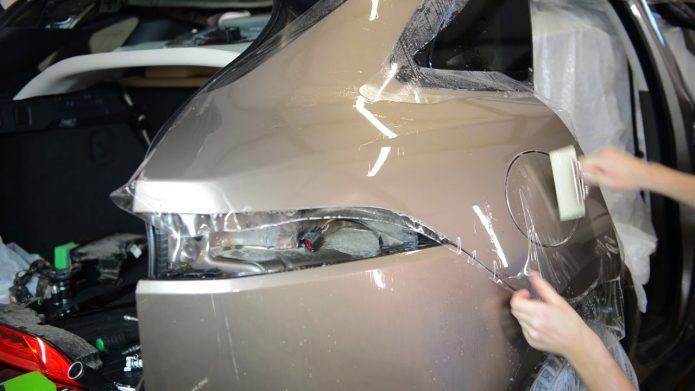
The elasticity of the anti-gravel film allows you to paste over almost any car body element.
Anti-gravel protection of the car body with a film has some disadvantages:
- Slightly mutes the color;
- Poor-quality material becomes cloudy from the sun or rain;
- High-quality film is an expensive material. Covering the body of a crossover costs from 150 to 180 thousand rubles.
Vinyl wrap
Decorative and protective vinyl film is also able to protect the coating of the car, but it is inferior to anti-gravel in terms of durability, although the price is not much lower. Vinyl cracks from temperature changes, so this protective coating is short-lived.
Vinyl is more often used as a decorative coating, to change the color of the car, or to mask body defects: chips, localized rust, deep scratches.
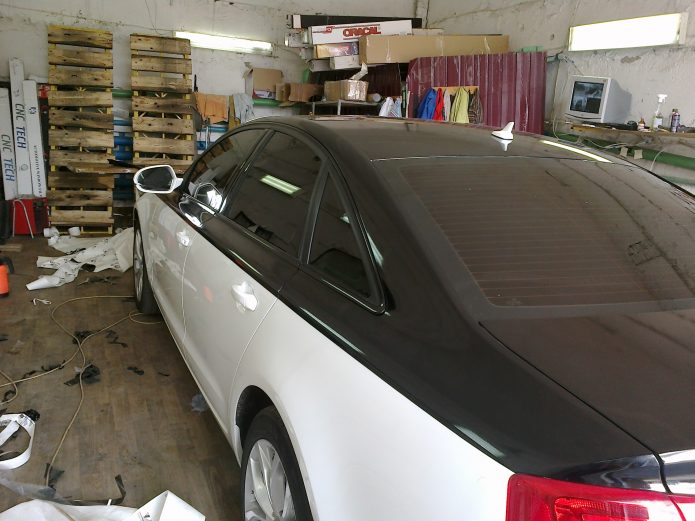
Vinyl does not lose its properties due to adverse weather conditions: scorching sun or heavy snowfall
Ceramic protection "liquid glass"
Liquid ceramic coating is a polish that minimizes the negative impact of aggressive substances (salt, chemicals), protects against tarnishing and minor scratches. "Liquid glass" enhances the brightness of the paint, which begins to shine in any weather.
Ceramic coating, popularly called "liquid glass", is a special mastic based on silicon compounds. The main component of the mastic is synthetic quartz, which hardens on contact with air and forms a thin (0,7-1,5 micron), but hard film on the body that can withstand even fairly massive stones.
The rigidity of ceramic coating is several times higher than that of car paint. On the body, covered with ceramic mastic, chips and scratches are practically not formed. The car, like an egg, is covered with a transparent shell. To date, "liquid glass" is the most durable and effective protection.
The processing process itself is not complicated, so you can handle the application of "liquid glass" yourself. The car is thoroughly washed before application so that even dust does not remain on it. But in the conditions of a garage, it is difficult to achieve perfect surface cleanliness, therefore experts recommend processing with “liquid glass” in a special box (chamber) of a car repair shop.

Liquid glass is absolutely transparent, because the car body acquires maximum brilliance and color depth
It is important! Within two days after applying the ceramic mastic, the composition polymerizes and gains strength. The vehicle must not be driven during this period.
It is enough to treat the body with “liquid glass” once a year. But from frequent car washes, the coating is still washed off. On average, liquid glass withstands 12-15 full-fledged car washing procedures using car shampoo.
"Liquid Case"
The cheapest way to protect the paintwork of the body is a “liquid cover”. It is a special liquid composition, which, after being applied to the surface, turns into a thin film. "Liquid cover" protects the coating from scratches and rust.
The composition is applied to the body with a brush or spray gun in three layers. The service life of such protection is no more than 15-20 days. But if the car gets caught in the rain, the “liquid cover” begins to peel off the body in shreds. When removed, such a protective film rolls into a roll.
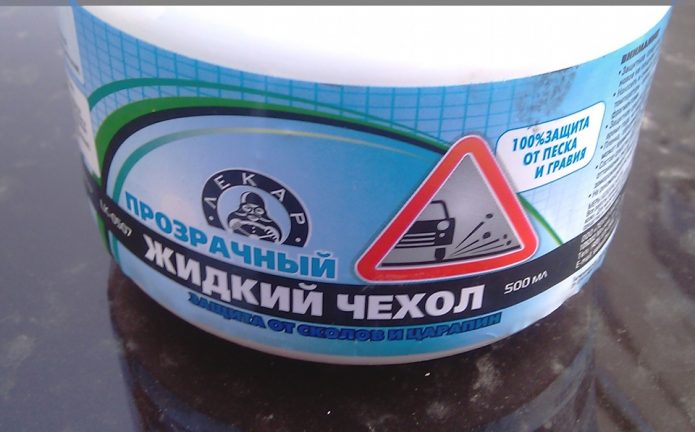
To quickly remove the liquid cover in the future, it is recommended to spread the first layer as thick as possible and not spare the liquid.
It is important! "Liquid cover" quickly begins to bubble, crack and spoil the appearance of the car, so this protection is recommended to be used only for one-time long-distance trips.
Protective polishes and waxes
Body polishing with special mastics or wax is the most popular way to protect paintwork. The method consists in applying a silicone-based paste or special wax to the surface. The composition fills small cracks, chips, scratches and forms a strong film on the body, which protects the coating from impacts of small stones and scratches. The polish actively resists the damaging effect of chemicals and precipitation on the paint.
Wax is the oldest way to protect the surface of a car. The waxed body acquires a pronounced gloss, hides minor scratches. Dirt and midges do not stick to the treated surface.
The cost of the body polishing procedure is low, so it is quite affordable for any car owner. But the disadvantage of such protection is the fragility of the coating. To maintain efficiency, the polishing procedure has to be carried out at least once every 3-4 months.
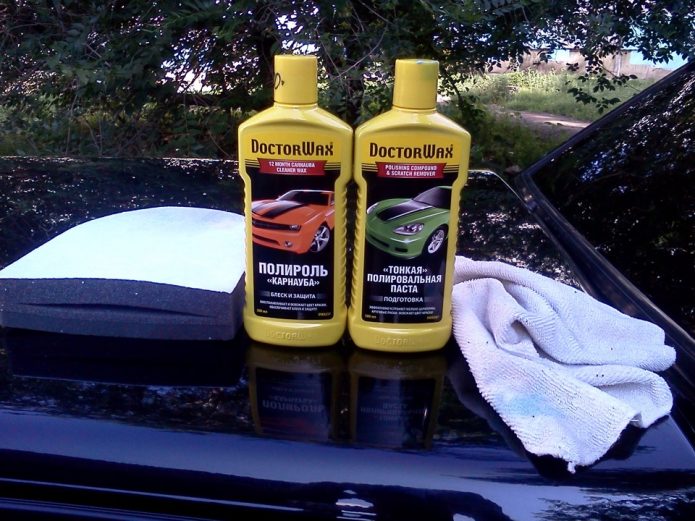
Protective polish forms a barely visible film that works like a mirror
The service life of the polishing composition depends on its quality. For example, Teflon compounds stay on the surface for no more than 3 months, resin polishes - up to 12 months. The most durable is nano-polishing. It has increased resistance to chemical and physical effects, retains its properties for 2-3 years.
Liquid rubber
The liquid rubber body protection technology was developed and put into production by Plasti Dip in 1972 from America. After a short time, a Chinese alternative to the original product appeared on the market, but its quality leaves much to be desired.
Liquid rubber is a thin seamless web obtained by applying a bitumen-based liquid composition to the body or its individual parts. A car coated with this composition acquires a matte surface, reliably protected from the mechanical effects of corrosion, precipitation and road chemicals.
Before applying such protection, it is not necessary to prepare the body, just wash the surface. Rubber hides small chips and scratches. But before covering a car with deep scratches or dents, preliminary body work will be required.
The disadvantage of liquid rubber is poor abrasion resistance. If you apply too much force during washing the car, ugly scuffs will appear on the surface. A jet of water during a non-contact wash can also break the adhesion of the canvas to the body.
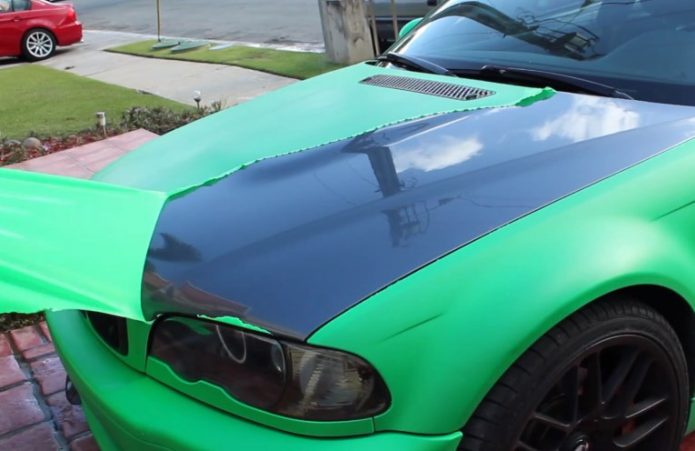
Liquid rubber becomes hard over time, which allows paint or varnish to be applied over it.
With careful handling, body protection with liquid rubber lasts for 2-3 years. At the end of the service life, the coating can be easily removed without harming the main paintwork.
Fabric case
The main purpose of fabric-based covers is to protect the hood of the car from stones and sand flying while driving. It is advisable to use such protection during long trips along the highway. Basically, these covers are made of eco-leather for specific car models.
There are models that protect 15-20 centimeters of the "muzzle" of the car and completely cover the hood. The disadvantage of such protection is the possibility of moisture accumulation under the cover, which can cause corrosion.
Plastic deflectors
The plastic lining on the hood, popularly referred to as the "fly swatter", is a visor, usually black. While the car is moving, the deflector directs air flows, and together remove insects and small stones, over the hood and windshield.

Despite the relative cheapness, hood deflectors are not in great demand among motorists.
The deflectors are attached to the hood with special clips. Some models involve drilling small holes in the hood. The cost of the lining ranges from 700 to 3000 rubles, depending on the model of the car.
Real users of plastic deflectors note that they only work at very high speeds, and in addition, they do not look very presentable on a car body. The disadvantage of deflectors is also that there is a small gap between it and the hood, into which snow is packed in winter. After dismantling the “visor”, scuffs remain on the hood, and if holes for fastening are drilled, the body begins to rust.
Top cars with the best body protection
Any body protection is just an additional measure to preserve the appearance of the car. It works well only if the surface of the machine is initially covered with a high-quality, reliable paint and varnish composition. Today, automakers use three types of paints:
- Nitroenamels. They are practically not used in new cars, since the surfaces painted with them quickly lose their brightness.
- Alcides. Low-price paints, unreliable in terms of protecting the body from corrosion.
- Acrylic. The best paints that preserve the depth of color. Resistant to mechanical and chemical influences. They consist of a coloring composition and a hardener.
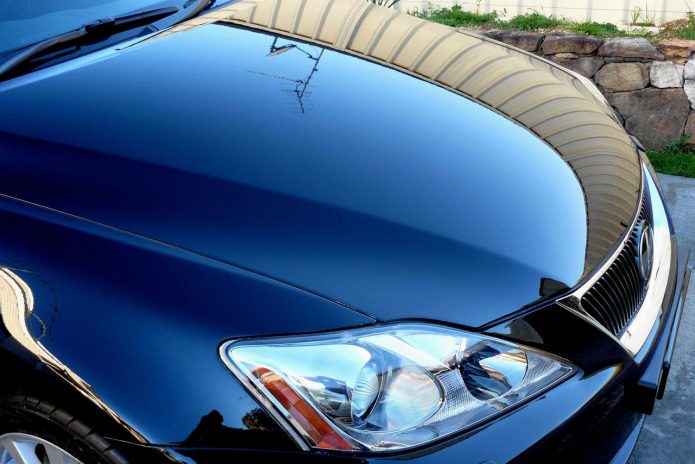
Factory paintwork is easier to protect than to restore
Most automakers are now moving to the use of acrylic coatings. But the thickness of the paint layer is different for different manufacturers and models of cars, so cars of the same year of manufacture, operated in the same conditions at regular intervals, look different. According to experts and real owners, the following car models have the highest quality paintwork:
- Mercedes. "Merci" is rightfully considered the most reliable in terms of quality paintwork. They shine like new even after several years of active use.
- BMW. Until recently, these Germans were not inferior in appearance to their compatriots. But in recent years, BMWs are losing their luster faster, especially singles and triples. Fives are considered the highest quality, which are practically not inferior to Mercedes.
- Volvo. High-quality coating, slightly inferior to Mercedes, but almost equal to BMW. The quality of the lacquer and scratch resistance is excellent.
- Audi, Volkswagen, Skoda. These brands are about on par, slightly inferior to previous models. A solid five for the quality of the paintwork can be put on Audi, which in some ways is ahead of even BMW.
- Cadillac. The varnish is good, high-quality, long-lasting gloss. All colors except black! Pure black non-metallics scratch at an incredible rate.
- Opel. The coating quality of these machines varies from lot to lot. Opels are more common with a good and durable shine. But exceptions to the rule still exist.
- Toyota and Lexus. More recently, Toyotas, especially black non-metallic ones, have been literally blown by the wind. Currently, the situation is improving, and Toyota began to bring their paintwork closer to the BMW.
- Nissan. The coating is durable for expensive models. The rest can not boast of brilliance.
- Lada (Grant. Priora, Kalina). Domestic models are stepping on the heels of Toyota. They resist scratches well and shine no worse than foreign cars.
- Subaru. Recently, the quality of the coatings of these machines began to approach BMW. The varnish has learned to shine, and for a long time.
Initially, high-quality paintwork is easier to protect with additional methods. If you purchased a car with a thin layer of paint, maintaining its appearance will require quite serious costs.
Each method of car body protection has its advantages and disadvantages. At the same time, the choice of a car owner is primarily based on the price of a particular service. Only one thing is undeniable - a protective coating is necessary for a car so that its presentable appearance is preserved as long as possible.
Discussions are closed for this page
